Karl Shuker's Blog, page 47
April 23, 2014
AN EXPLOSIVE ENIGMA FROM KALMYKIA – THE 'OTHER' MONGOLIAN DEATH WORM?
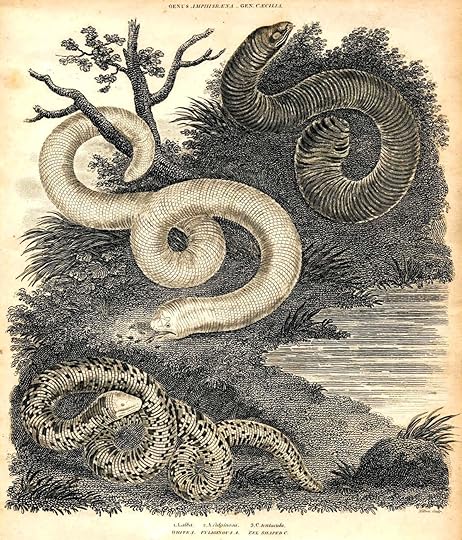 st1\:*{behavior:url(#ieooui) } Amphisbaenians and a tentacled caecilian illustrated in an engraving from 1811 – could the exploding 'worm' of Kalmykia be allied to one of these limbless herpetological forms?
st1\:*{behavior:url(#ieooui) } Amphisbaenians and a tentacled caecilian illustrated in an engraving from 1811 – could the exploding 'worm' of Kalmykia be allied to one of these limbless herpetological forms?A very curious type of vermiform mystery beast that may (or may not?) be allied to the notorious Mongolian death worm (click here, here, and here for a variety of ShukerNature investigations concerning this much-dreaded Gobi-dwelling cryptid) but which is much less well known even in cryptozoological circles has been reported from the steppes and desert dunes of Kalmykia. This is a region of Russiato the north of Chechnyaand Dagestan, and lies immediately to the west of Kazakhstan.
According to a letter of 6 January 1997 written to French cryptozoologist Michel Raynal by veteran Russian cryptozoologist Dr Marie-Jeanne Koffmann, this unidentified creature is referred to by the Kalmyks as the 'short grey snake'. Measuring 50 cm (20 in) long and 15-20 cm (6-8 in) in diameter, it has smooth grey skin, and is rounded at its anterior end, but terminates abruptly with a very short tail. So far, its local 'snake' appellation would seem to be appropriate (visions of amphisbaenians, i.e. worm-lizards, or even those limbless worm-like amphibians known as caecilians also come to mind).
However, it also has one characteristic that instantly sets it apart from any bona fide herpetological entity, and ostensibly places it among vermiforms of the invertebrate kind instead. For according to the Kalmyks, their so-called 'short grey snake' does not possess any bones.
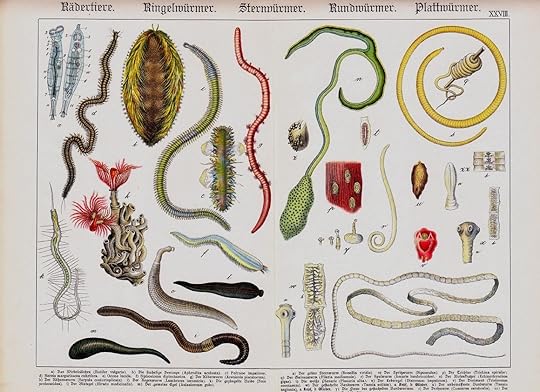 Worms of many types - a chromolithograph from 1886
Worms of many types - a chromolithograph from 1886
This would appear to be substantiated by their claim that if one of these beasts is struck hard in the middle of its back with a stick, it explodes - leaving behind a patch of slime or grease stretching more than a metre (3 ft) in diameter across the ground as the only evidence of its former existence. Although she is not absolutely certain (her original notes were destroyed during a burglary in her office), Dr Koffmann believes she was told that this animal is slow-moving, and moves in a worm-like manner. As to whether it is dangerous, however, some Kalmyksaffirm that it is, but others state that it is not.
No mention is given of any facial features (although Koffmann claims that a second, smaller variety also exists here, which has a clearly delineated mouth). In any event, Kalmykia's exploding 'worm' exhibits sufficient differences from the Mongolian death worm for me to see little reason for assuming that these two creatures share anything other than the dubious honour of being presently unrecognised and thus ignored by modern-day science.
Then again…
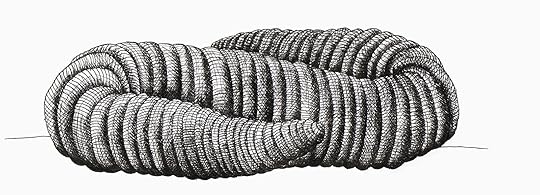 A very vermiform representation of the Mongolian death worm (© Tim Morris)
A very vermiform representation of the Mongolian death worm (© Tim Morris)This ShukerNature post is exclusively excerpted from my book The Beasts That Hide From Man (2003), which contains the most comprehensive documentation of the Mongolian death worm (as featured on its front cover) ever published.
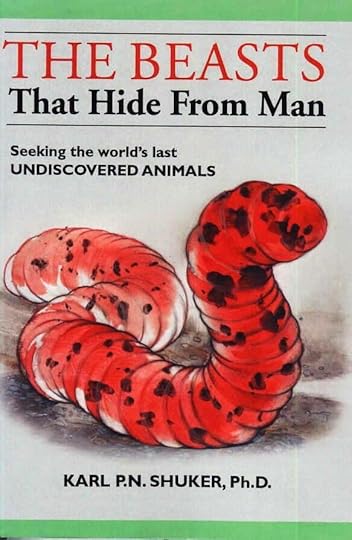
Published on April 23, 2014 20:19
April 22, 2014
SOME FISHY FINDINGS REGARDING THE MONSTERS OF RUSSIA'S LAKE LABYNKYR
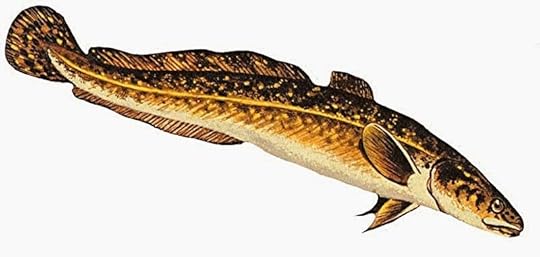 The burbot – does this unusual fish hold the key to the monsters of Lake Labynkyr?
The burbot – does this unusual fish hold the key to the monsters of Lake Labynkyr?Almost 9 miles long, 2.5 miles wide, and up to 260 ft deep in one particular section, Lake Labynkyr in far-eastern Russia's Yakutia (Sakha) Republic is not only a large but also a very remote body of icy-cold freshwater. It is not frequently visited by outsiders, but those hardy local hunters that have braved its location's inhospitable climate have sometimes returned home with stories of formidable aquatic monsters inhabiting its chilly depths - stories that date back as far as the 19th Century but which have received increasing public and scientific attention since the 1950s.
 Lake Labynkyr (© LosApos.com)
Lake Labynkyr (© LosApos.com)Some tell of a dark-grey beast with an enormous mouth that has allegedly devoured their dogs when they have leapt into the lake to retrieve shot ducks. Others speak of a black, long-necked, snorting creature with a snake-like head that preys upon geese and reindeer. In my book In Search of Prehistoric Survivors (1995), I noted that according to Anatoly Pankov, a chronicler of mysterious happenings in this part of the world, sometime during the 1950s one such creature supposedly raised its neck above the lake's surface in full view of a team of geologists and lunged upwards to snare a flying bird between its jaws while also being watched by a number of astonished reindeer hunters.
In 1962, Dr Sergei Klumov suggested that an unknown species of amphibian may exist here - a possibility also contemplated by Soviet geologist Dr Viktor Tverdokhlebov, who visited Lake Labynkyr during Russia's Stalinist era. A relict reptile was an alternative candidate proffered by Tverdokhlebov, but he was unable to put either option to the test, as he did not report any sightings of monsters there. Nor did any team members from a Russian expedition that visited in 1963, or an Estonian team in 1964. Yet the legend of mystery beasts lurking beneath its water surface continues.
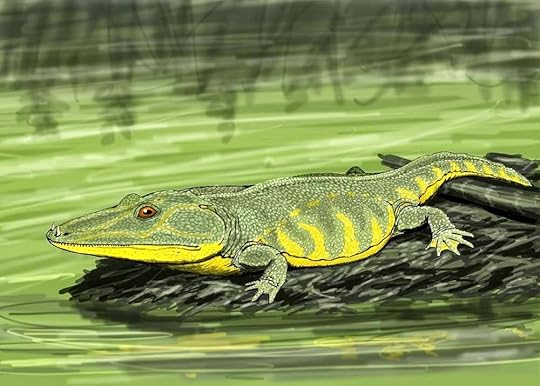 Modern reconstruction of Mastodonsaurus - a very big and notably large-mouthed amphibian from the Middle Triassic Period (public domain)
Modern reconstruction of Mastodonsaurus - a very big and notably large-mouthed amphibian from the Middle Triassic Period (public domain)Thanks to the intriguing findings of a team that visited this mysterious lake last month, however, the true nature of its supposed monsters may be very different from the accounts and theories noted above, but no less interesting either.
The team in question was composed of divers from the Russian Geographic Society and the Diving Sport Federation of Russia. Their mission had three separate goals – to collect samples for formal scrutiny and analysis by scientists investigating the long-suspected possibility that an underwater link exists between Lake Labynkyrand the equally mysterious Lake Vorota, almost 20 miles away; to break the world record for the deepest under-ice dive; and to look out for Labynkyr's fabled monsters. By the end of their visit, the team had accomplished both of their first two goals, and had also obtained some thought-provoking findings of great relevance to their third.
As documented by the Siberian Times on 21 April 2014, team member Lyudmila Emeliyanova, an Associate Professor of Biogeography, revealed that during a previous visit here (in 2009):
"It was our fourth or fifth day at the lake when our echo sounding device registered a huge object in the water under our boat.
"The object was very dense, of homogeneous structure, surely not a fish nor a shoal of fish, and it was above the bottom. I was very surprised but not scared and not shocked, after all we did not see this animal, we only registered a strange object in the water. But I can clearly say - at the moment, as a scientist, I cannot offer you any explanation of what this object might be."
And that was not all - further sonar readings of this same kind were subsequently recorded by her equipment:
"I can't say we literally found and touched something unusual there but we did register with our echo sounding device several seriously big underwater objects, bigger than a fish, bigger than even a group of fish."
In contrast, the largest life forms detected in the lake during this latest visit, and which were photographed by team member Alexander Gubin, were fishes up to 4 ft long that the team referred to as dogfishes – which is something of a mystery in itself.
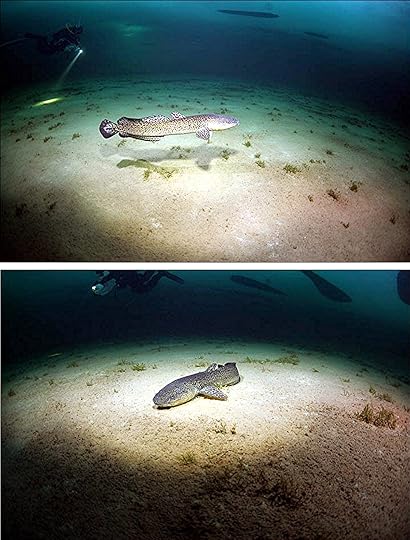 Two photographs of 'dogfishes' encountered during the Russian team's visit to Lake Labynkyrin March 2014 (© Alexander Gubin/Siberian Times)
Two photographs of 'dogfishes' encountered during the Russian team's visit to Lake Labynkyrin March 2014 (© Alexander Gubin/Siberian Times)For whereas the term 'dogfish' is normally applied to various relatives of sharks, I was readily able to identify the fishes in Gubin's photographs as being something totally different.
Namely, a cod-related freshwater species known as the burbot Lota lota. So, could 'dogfish' be a colloquial name used in Russia for the burbot?
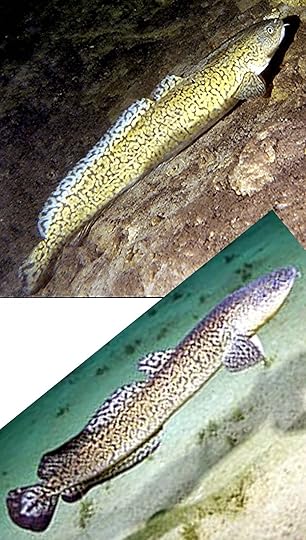 (Top) A burbot (© Achim R Schloeffel/Wikipedia); (Bottom) One of the Russian team's 'dogfishes' (© Alexander Gubin/Siberian Times)
(Top) A burbot (© Achim R Schloeffel/Wikipedia); (Bottom) One of the Russian team's 'dogfishes' (© Alexander Gubin/Siberian Times)Carnivorous by nature, this very distinctive species – the world's only freshwater gadiform - is known to attain a total length of up to 4 ft. However, larger specimens may conceivably exist in this large but little-disturbed lake.
Untroubled by any large-scale threat of predation by other animals or persecution by humans, and encouraged to attain an exceptionally large size by the lake's chilling temperature in the same way that fishes and invertebrates famously do in the freezing waters off Antarctica, perhaps undiscovered mega-burbots are the real monsters of Labynkyr.
For more information on Russian lake monsters, check out my book Karl Shuker's Alien Zoo (CFZ Press: Bideford, 2010).

Published on April 22, 2014 16:41
April 20, 2014
WHITHER THE LOST WHITE EAGLES OF EUROPE AND AMERICA?
On Easter Monday 2013, my dear mother, Mary Shuker, passed away. So today, on Easter Monday 2014, I am dedicating this ShukerNature blog post to her. God bless you, little Mom - I shall always love you, miss you, and wish that you were here with me still.
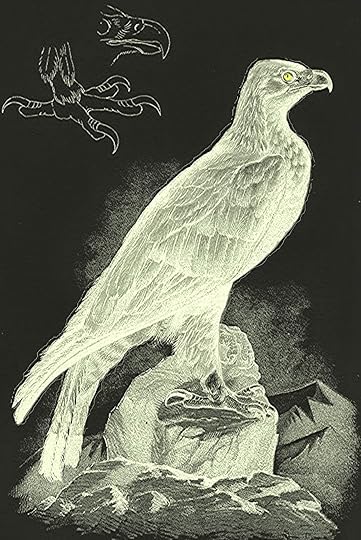 Computer-created representation of a white eagle in mountain darkness (© Dr Karl Shuker)
Computer-created representation of a white eagle in mountain darkness (© Dr Karl Shuker)To misquote Oscar Wilde: To lose one white eagle may be regarded as a misfortune. To lose both looks like carelessness.
In the annals of ornithology, only two types of white eagle have been reported – one in Europe, and one in North America. Both, however, are long vanished, not only from our planet but also from contemporary records. Indeed, even their erstwhile existence is known from only the most sparse and fragmentary details, and has been largely forgotten for centuries - until now. I first learned of these birds from their tantalisingly short entries in Extinct Birds (2012) by Julian P. Hume and Michael Walters, and was determined to learn more about them. Consequently, after having spent much time painstakingly tracing and collating it, I now have pleasure in documenting here the very scattered, disparate history of what appear to have once been a pair of real and extremely impressive but highly mysterious raptors, of unconfirmed taxonomic status, which were lost to the world before any physical trace of their former presence had been obtained for scientific examination.
The earliest documentation of the European white eagle appears to occur in the writings of the 13th-Century German Dominican friar and Catholic bishop Albertus Magnus. His words were reiterated three centuries later in a couple of brief references in the year 1555. The first of these was by Swiss naturalist Conrad Gesner (1516-1565), who documented it on p. 199 of his Avium Natura(1555), the bird tome in his celebrated five-volume, 45,000-plus-page encyclopaedia Historiae Animalium (published 1551-1558). He referred to it as Aquila alba sive Cygne ('the white or swan eagle'), and Aquila albasubsequently became its official binomial name in taxonomic nomenclature. Similarly, French naturalist Pierre Belon (1517-1564) referred to this bird as the 'aigle toute blanche' ('all-white eagle') on p. 89 of his L'Histoire de la Nature des Oyseaux (1555). Following Gesner's lead, Italian naturalist Ulisse Aldrovandi (1522-1605) termed it Aquila alba seu cycnea on p. 231 of his Ornithologiae, hoc est de Avibus Historia (1599).
 An illustration of the European white eagle from 1790
An illustration of the European white eagle from 1790On p. 63 of his Onomasticon Zoicon: Plerorumque Animalium Differentias et Nomina Propria Pluribus Linguis Exponens (1668), Somerset-born natural history writer Walter Charleton (1619-1707) called it the white eagle. And it was Aquila alba to Poland's Reverend Gabriel Rzaczynski (1664-1737) on p. 299 of his tome Historia Naturalis Curiosa Regni Poloniae (1721), who also referred to it as Aquila Cygnea Aldrovandi in a subsequent publication of 1745 entitled Auctarium Historiae Naturalis Regni Poloniae Magnique Ducatus Lituaniae Annexarumque Provinciarum in Puncta. Five years later, Jacob T. Klein briefly documented it on p. 42 of his Historiae Avium Prodromus cum Praefatione de Ordine Animalium in Genere (1750). In 1760, French zoologist Mathurin J. Brisson (1723-1806) documented Aquila alba on p. 424 of his tome Ornithologia, sive Synopsis Methodica Sistens Avium Divisionem in Ordines, Sectiones, Genera, Species, Ipsarumque Varietates. Acclaimed French naturalist Georges-Louis Leclerc, Comte de Buffon (1707-1788) also alluded to white eagles in his multi-volume magnum opus Histoire Naturelle (1749-1788).
English ornithologist John Latham (1740-1837) documented this raptor in three separate publications – calling it the white eagle on p. 36 of his famous treatise A General Synopsis of Birds(1781), applying to it the taxonomic binomial name Falco cygneus on p. 14 of his Index Ornithologicus (1790), and commenting upon what he believed its status to be in his General History of Birds (1822). Meanwhile, on p. 257 of his own version (published in 1788) of Linnaeus's pioneering taxonomic work Systema Naturae, German naturalist Johann F. Gmelin (1748-1804) had christened it Falco albus (but as the genus Falcowas subsequently limited to falcons, this was later reverted to Aquila albaby other writers). In 1809, English zoologist George Shaw (1751-1813) dubbed it Falco cygneus on p. 76 of the bird volume in his sixteen-volume series General Zoology (1809-1826).
And this seems to be the full (or at the very least the major) extent of the European white eagle's formal documentation in the scientific literature – but what did these various accounts actually say about it? Sadly, the answer to that question is…very little indeed. Moreover, as was typical back in those far-distant days, each work did little (if anything) more than simply regurgitate what had been published in the previous ones. So here is a summary of the sparse, salient details gathered from these sources.
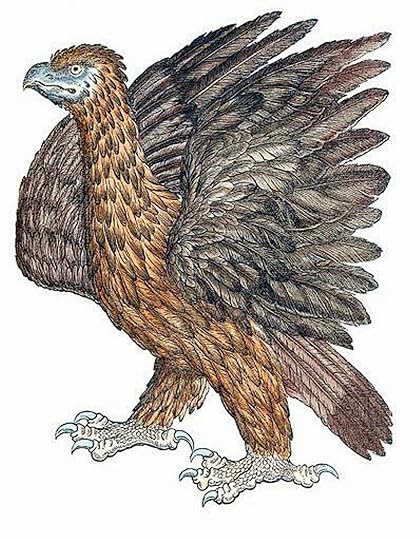 Gesner's illustration of the golden eagle
Gesner's illustration of the golden eagleAlbertus Magnus stated that the European white eagle preys upon rabbits, hares, and sometimes fishes too, and that it inhabits the Alps, as well as the rocks bordering the Rhine, where, according to the Rev. Gabriel Rzaczynski, it builds its nests. Brisson stated that it is as large as the familiar golden eagle Aquila chrysaetos, but is entirely white - as white as snow. Rzaczynski noted that it has a 9-ft wingspan, and likened its white plumage to that of a swan. He also claimed that a specimen had been killed in Poland and its body shown to the country's monarch, John II Casimir Vasa ((but its subsequent fate is apparently unknown). Due to its fish-eating proclivities, Aldrovandi suggested that it may be more closely related to the osprey than to any eagle (but there are a number of eagle species famed for their piscivorous behaviour).
All of the European white eagle's early chroniclers presumed it to be a valid, distinct race in its own right. However, Buffon deemed all white eagles to be nothing more than varieties of the golden eagle. Conversely, although he included Buffon's opinion in his own coverage of the European white eagle within his 1781 publication, Latham decided to follow Brisson's stance in categorising it as a separate species – but by 1822 he had changed his mind, labelling it as merely a colour variety of the golden eagle after all.
Not that it mattered much by then anyway, except in a strictly academic sense, because sightings of the European white eagle were no longer being reported. Indeed, in his 1809 bird volume, Shaw had already noted that "it does not appear to be known to modern naturalists". Tragically, this pallid-plumed, winged prince of the alpine mountains had gone, forever. No records exist regarding the reason for its disappearance, but such a spectacular bird would unquestionably have been a major target for hunters, seeking to add its immaculate form to their trophies (a comparable fate befell the white tiger in India). If, as does seem likely, it existed as a discrete, self-perpetuating population of a distinct colour morph of the golden eagle, presumably either albinistic or (more probably) leucistic, and therefore the physical expression of a recessive mutant allele, it would not have been common to begin with, so would have been unable to withstand persecution for any notable length of time. Occasionally, a freak partially-white specimen of the golden eagle is reported today, usually in North America, but not from any self-perpetuating white population.
 A partially-white (leucistic) golden eagle sighted in Colorado in July 2008 (© Constance Hass)
A partially-white (leucistic) golden eagle sighted in Colorado in July 2008 (© Constance Hass)I am not aware of any preserved specimens of the European white eagle, and the present ShukerNature post is the most comprehensive documentation of this hitherto all-but-forgotten mystery bird ever written.
As for America's equivalent: This is – or was – the Louisiana white eagle Aquila candidus, also known as the conciliating eagle. It was originally documented by Antoine-Simon le Page du Pratz (1695?-1775) in his tome Histoire de la Louisiane (1758). Although born in Europe, this noted ethnographer, historian, and naturalist had lived in Louisiana from 1718 to 1734, where he had befriended the leaders of the Natchez nation there and had also learned their language. On p. 75 of his work, he referred to a white eagle that was smaller and rarer than the golden eagle, but more handsome, being almost entirely white – only the tips of its wings' quills were black. These quills were purchased at high prices by the Natchez people, who valued them greatly and apparently used them to compose the fan section of their symbol of peace, known as the calumet or pipe of peace (a very long reed ornamented with feathers).
On p. 197 of the second (bird) volume in his two-volume treatise Arctic Zoology (1785), documenting the mammals and birds of North America, Welsh naturalist Thomas Pennant (1726-1798) merely paraphrased Du Pratz's documentation of the Louisiana white eagle. So too did Latham in his 1781 tome. On p. 258 of his version of Linnaeus's Systema Naturae, Gmelin accorded this raptor the taxonomic binomial name Falco candidus, whereas in 1809 George Shaw dubbed it Falco conciliator on p. 77 of the bird volume in his General Zoology.
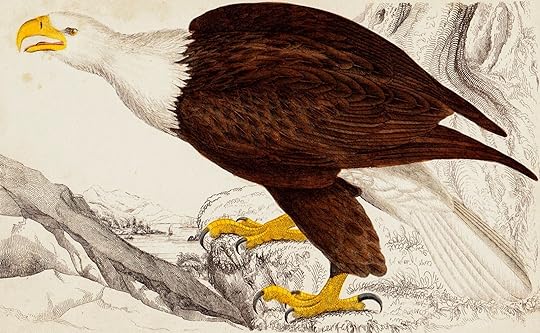 Hand-coloured engraving from 1840 of an adult bald eagle
Hand-coloured engraving from 1840 of an adult bald eagleBut what was this enigmatic bird, which, just like its European equivalent, has long since disappeared, both physically and figuratively? Its last notable mention was by English ornithologist Hugh E. Strickland (1811-1853), who included it in his posthumously-published book Ornithological Synonyms (1855). Here he listed its name as a synonym of the bald eagle Haliaeetus leucocephalus, and questioned the accuracy of du Pratz's original account of it. Yet other zoological descriptions included by du Pratz in his book were accurate, so why shouldn’t his account of the Louisiana white eagle have been too? French naturalist Charles-Nicholas-Sigisbert Sonnini de Manoncourt (1751-1812) speculated that the Louisiana white eagle and the European white eagle were one and the same form, but du Pratz claimed that the former raptor was smaller than the golden eagle, whereas according to Brisson the European white eagle was the same size as the golden eagle. If these claims were correct, this indicates that the two white eagles were distinct from one another.
Worth noting is that a few confirmed specimens of white or mostly white bald eagle have been documented in modern times, but not a small, self-perpetuating population of them, which seems to have been true with the Louisiana white eagle. Certainly, Du Pratz did state that this latter raptor was rare; and in view of how valuable its feathers were, it may well have gone the same way as other birds whose handsome plumes attracted similarly unwelcome attention - such as the New Zealand huia (click here for more details) and the Hawaiian mamo, for instance.
Whatever the answer, the world is surely a poorer place without the sight of a magnificent white eagle soaring skyward among the lofty peaks of some stark mountain, like a pale feathered phantom whose mighty pinions bear it ever higher toward that great Empyrean above.
Nor are they the only mystery eagles on record. Remind me, another time, to recall for you the tiger eagle of Latvia, or the fierce eagle of Astrakhan, or the Macarran eagle of South America. And don't forget to click here for my extensive ShukerNature documentation of Washington's eagle – the most controversial lost eagle of all.
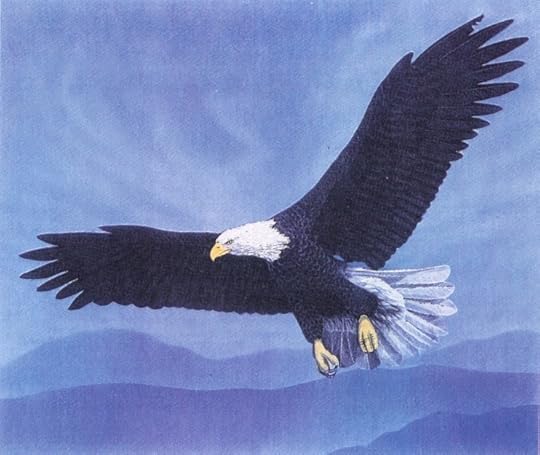 Beautiful painting of an adult bald eagle in soaring flight (© William Rebsamen)
Beautiful painting of an adult bald eagle in soaring flight (© William Rebsamen)
Published on April 20, 2014 21:40
April 15, 2014
WRONG-FOOTING A ONE-LEGGED MYSTERY SNAKE FROM CHINA
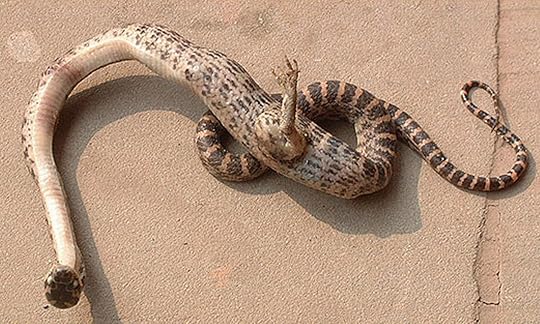 The only known photograph of China's one-legged mystery snake (© CEN/Europics) - click it to enlarge it
The only known photograph of China's one-legged mystery snake (© CEN/Europics) - click it to enlarge itSome zoological photographs are so bizarre that long after they first hit the news headlines, they still continue to circulate online, like restless ghosts doomed to wander forever down the highways and byways of the worldwide web, resisting all attempts to expose them as hoaxes or explain them as grotesque yet nonetheless natural phenomena. One such image that seems to fall into the latter category is the example that opens this present ShukerNature blog post – namely, a supposed one-legged, claw-footed snake from China.
This anomalous serpent made its media debut as far back as mid-September 2009, since when it has been the online focus of various less than credible claims and all manner of decidedly credulous comments, but no rigorous, in-depth assessment. Consequently, I felt that it was high time that this sorry situation was rectified, so here is my own personal appraisal of this very curious case.
The story broke on 14 September 2009, with news reports worldwide presenting the now-(in)famous photograph reproduced above of a dead snake seemingly possessing a single small but perfectly-formed claw-footed leg, and providing the following scant details concerning it. One typical report appeared in the UK's Daily Telegraph newspaper for that particular date, and provides the standard set of details reiterated in all other media accounts that I have seen. It stated that Mrs Duan (aka Dean) Qiongxiu, a 66-year-old woman from Suining in Southwest China, had woken up during the middle of the night, heard a scratching sound, turned on her bedroom's light, and then, in her quoted words, "saw this monster working its way along the wall using his claw". She was so frightened by it that she grabbed one of her shoes and beat the unfortunate if uncanny serpent to death before preserving its battered carcase – measuring 16 in long and as thick as a human little finger - in a bottle of alcohol. It was subsequently forwarded to the Life Sciences Department at China's West Normal University in Nanchang. Snake expert Long Shuai was quoted as saying: "It is truly shocking but we won't know the cause until we've conducted an autopsy".
Those, then, are the facts of this case – such that they are. Not even the snake's species is identified. However, a popular identity nominated in various internet reptile forum/discussion groups is Dinodon rufozonatum, a colubrid with a wide distribution in East Asia, including China. It measures up to 28 in long, but is very slender, with brown background colouration marked with transverse crimson bands dorsally, pearl-coloured ventrally. It preys upon a wide range of small animals, including other snakes, lizards, small birds, fishes, and frogs, but is not believed to be venomous. This species certainly resembles the mystery snake in the photograph.
 A Chinese specimen of Dinodon rufozonatum (©Zhangmoon618/Wikipedia)
A Chinese specimen of Dinodon rufozonatum (©Zhangmoon618/Wikipedia)As for the results of the autopsy, more than four-and-a-half years later the world is apparently still waiting for them, because as far as I am aware, none have ever been made public. All that we do have, therefore, is supposition, and plenty of it, but nothing substantiated by corroborative evidence. So, based solely upon its appearance as portrayed within this single photo (I have never seen any others of it), how can the one-legged snake of China be explained?
Three plausible theories exist (i.e. discounting those claiming it to be an unnatural freak created in some secret laboratory, an alien entity, a radiation-induced mutant, or some paranormal aberration of occult origin).
Theory #1 is that it is a hoax. In other words, either the photograph is a fake image created by computerised photo-manipulation, or it is real but depicts a skilfully-manufactured model or comparable artifact. Despite much online research, I have found no evidence to support either of these possibilities, and none of the famous hoaxbusting websites has outed it either.
Theory #2 is that the creature is genuine and represents a striking, extreme example of atavism, i.e. the spontaneous development by an individual of a morphological feature possessed by far-distant ancestral forms or species but normally lost in their present-day descendants. I have many cases of atavism on file, covering a wide range of examples and species (click here for my ShukerNature blog post on atavistic extra toes in horses). Particularly pertinent to this case, however, are those featuring whales and other cetaceans exhibiting rudimentary external hind limbs – normally, cetaceans lack such limbs and even the pelvic girdle itself is very small. A comparable, but even more specialised situation occurs in snakes.
Millions of years ago, the ancestors of snakes possessed four well-formed legs and two limb girdles, but these became ever more reduced in form during ophidian evolution, so that modern-day snakes have entirely lost their forelimbs and pectoral girdle as well as – in most cases - their pelvic girdle and hind limbs. Famously, however, boas and pythons still possess a vestigial pelvic girdle and rudimentary external hind limbs. These latter limbs take the form of a pair of very small spur-like femur bones (known as pelvic or anal spurs) appressed to their body wall (on either side of the vent in males).
Could the claw-footed leg of China's unipodal serpent wonder therefore be an evolutionary, atavistic throwback to the snakes' distant antecedents? If so, a genetic mutation may have occurred during its embryonic development that somehow unlocked the still-preserved but normally-suppressed code in its DNA for creating a well-formed limb, foot, and clawed digits.
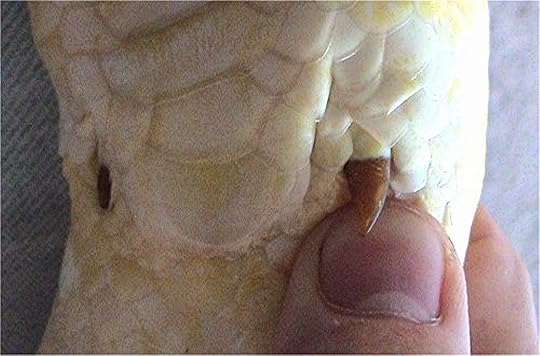 The pelvic (anal) spurs on a male albino Burmese python (© Dawson/Wikipedia)
The pelvic (anal) spurs on a male albino Burmese python (© Dawson/Wikipedia)Although the various fully-verified cases of hind-limbed cetaceans demonstrate that such a concept is not beyond the realms of possibility, there are some serious problems to consider when attempting to apply this same scenario to China's legged snake. First and foremost is the anomalous limb's position. Far from being situated in the vicinity of where either the snake's pectoral girdle or its pelvic girdle would be if it too had been recalled into existence via atavism, the leg is located, very oddly, in the middle of the snake's body instead, seeming to emerge from somewhere in the rib-cage. Even in atavism, a recalled appendage normally arises in the anatomically correct location for it, not in some entirely incorrect position. Secondly, the foot's orientation is wrong too, as its sole is facing forward, towards the proximal end of the snake, instead of facing backward, like all animal feet do. Thirdly, the limb, feet, and clawed digits appear to be fully-developed, not rudimentary or at least incompletely formed, like hind limbs in whales and other examples of atavistic appendages normally are. Consequently, I consider it unlikely that the limb of China's legged snake is an atavistic appendage.
Theory #3 is that the leg does not belong to the snake, but rather is from some originally external source that the snake has swallowed, and has burst through its gut and body wall. This could have happened if, for instance, the snake had swallowed whole (as snakes generally do) a seized lizard or toad (both of which are animal types represented in China by species with limbs resembling the snake's ambiguous example), and the still-living victim had kicked out violently while trying to escape from the snake's gut.
Three features of the snake make this prospect a plausible one. Firstly, the region of the snake's body from which the leg is emerging is swollen both fore and aft, which would be consistent with the presence there of the snake victim's ingested body. Secondly, at the base of the leg is a swollen, pedicel-like region, which could conceivably be an accumulation of scar tissue resulting from healing of the hole in the snake's body wall that had been created when its victim kicked through it. Thirdly, the fact that the sole of the foot points forward is inconsistent with its being an atavistic limb of the snake but is wholly consistent with its being the foreleg of a prey victim that had been swallowed head-first, as is normal practice by snakes.
Incidentally, confirmed, comparable cases have been recorded from antelope-ingesting pythons whose victims' horns have pierced through their ophidian engulfers' gut and body wall.
There has been some online speculation as to whether such rupturing of the snake's body wall may actually have occurred only when the woman beat it to death (i.e. the leg was not present externally prior to this), and that her description of the snake as being legged beforehand was therefore mistaken or incorrectly reported. If this were correct, however, there would not be any presence of what appears to be scar tissue consistent with healing of the hole. Instead, all that would be present would be just a unhealed hole with the leg protruding directly through it and probably stained at its base with congealed blood that had leaked out through the hole. Yet no such blood is visible there in the photograph.
Obviously, an autopsy, or even a mere x-ray, of the snake's body would readily reveal whether its gut did indeed contain the body of a prey victim and also whether the mysterious leg belonged to that victim. Equally, if the leg was instead an appendage of the snake itself, an autopsy would expose this. So it is a great puzzle why the results of the autopsy – always assuming, of course, that one was ever conducted – seem never to have been publicly released. Riddles like this legged snake need a solution, and the solution needs to be aired, even it is as mundane as a snake whose engulfed prey victim proved to be not just alive but also kicking – and very emphatically so. Otherwise they are destined to appear and reappear in the freak shows of cyberspace ad infinitum, not to mention ad nauseam.
For more mysterious snakes, be sure to check out my book The Beasts That Hide From Man (Paraview: New York, 2003)

Published on April 15, 2014 02:19
April 8, 2014
DID I SEE AN UNDISCOVERED SPECIES OF GIANT PRAYING MANTIS IN SOUTH AFRICA?
 19th-Century engraving of a praying mantis
19th-Century engraving of a praying mantisThe longest species of praying mantis currently known to science is the giant stick mantis Ischnomantis gigas. Brown in colour, enabling it to blend in with the bushes upon which it lives and lies in wait for unwary prey to approach, this mighty mantid is native to Senegal, southern Mauritania, Burkina Faso, Mali, northern Nigeria, Cameroon, and Sudan. The longest specimen on record is an adult female collected in Kankiya, northern Nigeria, which measured a very impressive 17.2 cm long, and is now preserved in London's Natural History Museum.
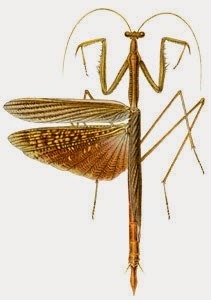 Ischnomantis media
, a smaller relative of
I.
gigas
(public domain)
Ischnomantis media
, a smaller relative of
I.
gigas
(public domain)Africa is also home to the world's largest mantis species, the aptly-named mega-mantis Plistospilota guineensis, native to Cameroon, Ivory Coast, Guinea, Liberia, and Ghana. Adult females grow up to 11 cm long, but are bulkier and heavier (weighing up to 10 g) than those of the giant stick mantis. They also have much larger wings; the wings of females belonging to the giant stick mantis I. gigas are so small that the females are rendered flightless.
But could there be even bigger species of mantid still awaiting formal scientific discovery and description? The reason why I ask this question is that a few years ago I had a first-hand encounter with a mysterious giant mantis, one that I was unable to identify and which has puzzled me ever since. So I am now documenting it here – as an online ShukerNature exclusive – in the hope that someone reading this post of mine may be able to offer a solution.
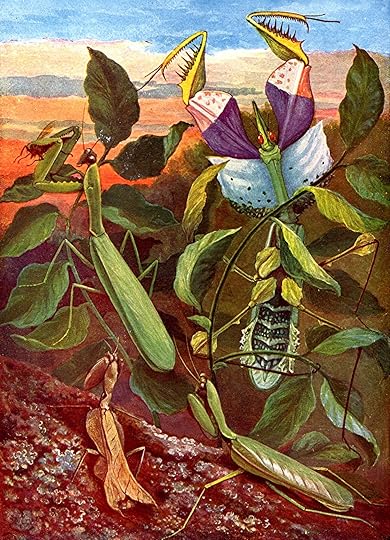 Mantids of many kinds (public domain)
Mantids of many kinds (public domain)In November 2008, my mother Mary D. Shuker and I spent four days at the private Shamwari Game Reserve, situated just outside Port Elizabeth in South Africa's Eastern Cape. On the last day of our stay there, just a few moments before the car arrived to take us and some other Shamwari guests back to the airport at Port Elizabeth, one of the safari guides walked over towards where we were all waiting, and squatting on the outstretched palm of his right hand was what I can only describe as an absolutely enormous praying mantis.
Brown in colour and very burly, this extraordinary specimen was so big that it was easily the length of his entire hand, and it was very much alive. Its 'praying' front limbs were moving slightly, and its head turned to look at us as we gazed at it in astonishment. As it made no attempt to fly away, however, I am assuming that it was flightless.
Frustratingly, my camera was packed away in one of my cases, so I couldn't take any photographs of this amazing insect. Nor could I question the guide about it, because at that same moment the car arrived to take us to the airport, so the guide walked off, still carrying the huge mantis on his hand.
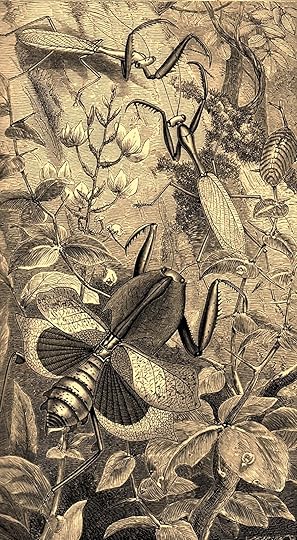 19th-Century engraving illustrating a selection of mantids
19th-Century engraving illustrating a selection of mantidsNeedless to say, I have never forgotten that spectacular creature, and I have sought ever since to uncover its taxonomic identity, but I have been unable to reconcile it with any mantis species recorded from South Africa (or, indeed, from anywhere else for that matter!).
So what wasthis mystery mantis of truly monstrous dimensions? If anyone can provide an answer, I'd love to hear from you!
 Mom (on right) with a fellow guest in front of Long Lee Manor, our place of residence while staying in Shamwari Private Game Reserve, South Africa, November 2008 (© Dr Karl Shuker)
Mom (on right) with a fellow guest in front of Long Lee Manor, our place of residence while staying in Shamwari Private Game Reserve, South Africa, November 2008 (© Dr Karl Shuker)
Published on April 08, 2014 02:32
April 4, 2014
WHEN FLYING CATS WERE FLYING LEMURS
 Ventral and dorsal view of a Philippines colugo, plus an American false vampire bat (above), depicted in Plate 58 from the first volume of Albertus Seba's Thesaurus (1734)
Ventral and dorsal view of a Philippines colugo, plus an American false vampire bat (above), depicted in Plate 58 from the first volume of Albertus Seba's Thesaurus (1734)Colugos must surely be among the most bizarre yet bewitching of all mammals. Native to the tropical forests of southeast Asia, most famous for the extensive gliding membrane (patagium) connecting their limbs, tail, and even the digits of their paws, and as big as a medium-sized possum or very large squirrel, the two modern-day species of colugo are the only surviving members of the mammalian order Dermoptera.
 Photograph of a colugo at rest upon a tree trunk (public domain)
Photograph of a colugo at rest upon a tree trunk (public domain)The larger and more familiar of these two species is the Philippines colugo Cynocephalus volans, which is endemic to this multi-island southeast Asian nation, and measures up to 17 in long. The second, smaller, and less familiar species is the Malayan or Sunda colugo Galeopterus variegatus, but this colugo has a much wider distribution - occurring in Borneo, Java, Sumatra, Singapore, peninsular Malaysia, Cambodia, Vietnam, Thailand, and Laos.
Widely deemed from the findings of recent molecular phylogenetic studies to be the primates' closest living relatives, these extraordinary yet surprisingly little-known gliding mammals are also called caguans and cobegos, as well as flying lemurs - even though they glide rather than fly and are not lemurs!
Perhaps the most memorable description of a colugo that I've ever read appears in Bill Garnett's book Oddbods! (1984):
"Imagine a floppy shopping bag with an avocado sticking out sideways at the top; hang it by claws beneath a branch; put a huge round eye on the avocado - and cover the lot in a soft furry pelt, mottled fawn and grey. You've now got yourself a colugo."
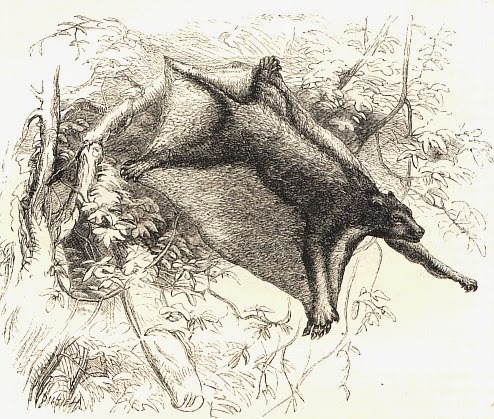 19th-Century engraving of a colugo gliding, revealing its extensive patagium
19th-Century engraving of a colugo gliding, revealing its extensive patagiumBut what on earth (or in the air!), I hear you ask, do colugos have to do with flying cats? I'm very glad that you asked me that question!
Let me begin answering it by introducing the grotesque Asian bat-cat depicted in the eminent Jesuit scholar Athanasius Kircher's tome China Monumentis (1667). Kircher claimed that such creatures (which he referred to as flying cats - 'Catti Volantes' - in his Latin text) existed in the forested mountains of India's Kashmir Province, but that upon closer examination they merely proved to be bats, albeit ones as big as (if not bigger than) chickens or geese.
 Athanasius Kircher’s bat-cat engraving
Athanasius Kircher’s bat-cat engravingZoologically speaking, however, the animal in this weird illustration does not resemble a bat, not least because the membranes of its wings are much more extensive than those of bats. Instead, it may conceivably have been an early attempt to portray a colugo, because the bat-cat's wings are actually pictured as a membrane extending from the forelegs to the hind legs and onto the tail, exactly mirroring the gliding membrane of colugos. But it could well be that as someone not trained in zoology, Kircher might simply have considered colugos to be bats anyway
Moreover, a distorted, secondhand (or more) account of a colugo may explain traveller Marco Polo's curious mention of a still-unidentified beast from the Far East known as a cat-a-mountain. This was said to be a predatory cat with the body of a leopard but also with a strange skin that stretched out when it hunted, enabling it to fly in pursuit of its prey.
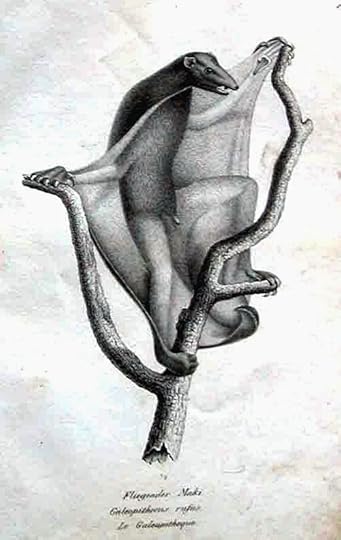 A somewhat aggressive-looking colugo in an early engraving
A somewhat aggressive-looking colugo in an early engravingA third potential case of cat-into-colugo reared its furry head in the 1990s, because that was when I uncovered the following intriguing but (at that time) previously-unpublicised report, entitled 'Flying Cat', which had been published in the volume for 1868 of a long-forgotten British journal entitled The Naturalist's Note Book:
"A nondescript animal, said to be a flying cat, and called by the Bhells pauca billee, has just been shot by Mr. Alexander Gibson, in the Punch Mehali [India]. The dried skin was exhibited at the last meeting of the Bombay Asiatic Society. It measured 18 inches in length, and was quite as broad when extended in the air. Mr. Gibson, who is well known as a member of the Asiatic Society and a contributor to its journal, believes the animal to be really a cat, and not a bat or a flying-fox [fruit bat], as some contend."
As I pondered in various articles and later in my book Dr Shuker's Casebook (2008), could this extraordinary animal have been an early example of a winged cat (click here for more info re these bizarre yet totally bona fide felids, and here for a video of one such individual)? Or was it a large species of bat – or even a colugo?
More than 145 years have now passed by since this strange creature was reported in The Naturalist's Note Book, yet its taxonomic identity remains unclear – or does it? In fact, thanks to a wonderful tome that I acquired only very recently, I have finally solved the tenacious mystery of Gibson's flying cat.
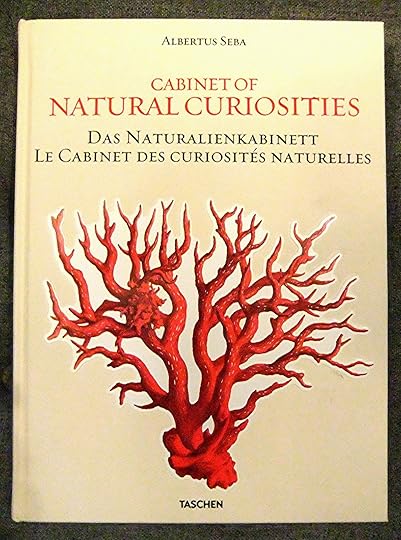 My copy of Taschen's spectacular compendium of the illustration plates from Albertus Seba's Thesaurus (© Taschen)
My copy of Taschen's spectacular compendium of the illustration plates from Albertus Seba's Thesaurus (© Taschen)Entitled Cabinet of Natural Curiosities and first published by Taschen in 2001 (mine is a 2011 reprint of it), the spectacular book in question that I purchased last month is a lavishly reproduced compendium of all of the glorious illustration plates from the four-volume magnum opus of Albertus Seba (1665-1736). An exceedingly wealthy Dutch businessman who was one of the most celebrated collectors of natural history specimens ever, Seba had amassed not one but two immense, internationally-renowned collections (click here to access a separate ShukerNature post containing additional details concerning Seba and his collections), and his four-volume tome, his Thesaurus as he entitled it, was basically a lavishly-illustrated catalogue of his collections' numerous specimens, containing more than 400 colour plates and published from 1734 to 1765.
 Portrait of Albertus Seba, by Jacobus Houbraken (1698-1780)
Portrait of Albertus Seba, by Jacobus Houbraken (1698-1780)Taschen's compendium of Seba's Thesaurus plates does not include any of his original accompanying text, which was written in both Latin and French and described each specimen in detail, but it does contains a lengthy introduction written by this compendium's German compilers. And it was tucked within this where, with great excitement and delight, I came upon an ostensibly inauspicious yet truly revelationary paragraph - a hitherto-cryptic nugget of knowledge that finally and fully elucidated the longstanding enigma of the flying cats. Contained within a section headed 'Curiosities and Special Attractions in the Thesaurus', this crucial paragraph reads as follows:
"A particular rarity in the Thesaurus are the so-called "Fliegende Katzen" (flying cats) and "Fliegende Hunde" (flying dogs) from tropical regions, although – contrary to what their names imply – they are not related to feline or canine species. Flughund (lit. flying dog) nevertheless remains the German designation for the fruit bat even today (in English it is also called a flying fox). Amongst the animals which Seba describes as "flying dogs" is a true fruit bat (Pteropus sp., I, 57, Figs. 1-2) and a tropical American false vampire bat (Vampyrum spectrum, I, 58, Fig. 1). Among the "flying cats" in the Thesaurus (I, 58, Figs. 2-3) we find the giant flying lemur of the Philippines (Cynocephalus volans), which together with another species forms a separate group of mammals."
Plate 58 is the illustration opening this present ShukerNature blog post, which does indeed portray the American false vampire Vampyrum spectrum (which happens to be the world's largest species of carnivorous bat) plus the ventral and dorsal view of a Philippines colugo. Below is the clearer version of this plate that appears in the Taschen compendium.
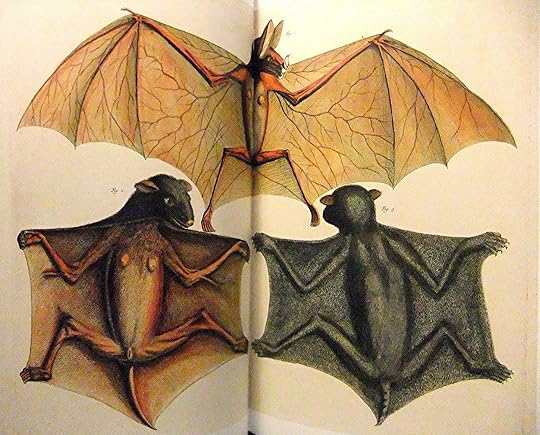 Ventral and dorsal view of a Philippines colugo, plus an American false vampire bat (above), depicted in Plate 58 as reproduced within the Taschen compendium of Albertus Seba's Thesaurus plates (© Taschen)
Ventral and dorsal view of a Philippines colugo, plus an American false vampire bat (above), depicted in Plate 58 as reproduced within the Taschen compendium of Albertus Seba's Thesaurus plates (© Taschen)Spurred on by this vital insight, yesterday I tracked down and consulted online a pdf of the original Seba's Thesaurus, which not only contained the plates but also Seba's own descriptions of the specimens depicted in them. And sure enough, the colugo was referred to by Seba in his descriptions as Felis volans ('flying cat'), and the Chat qui volé ('cat that flies'), as revealed here:
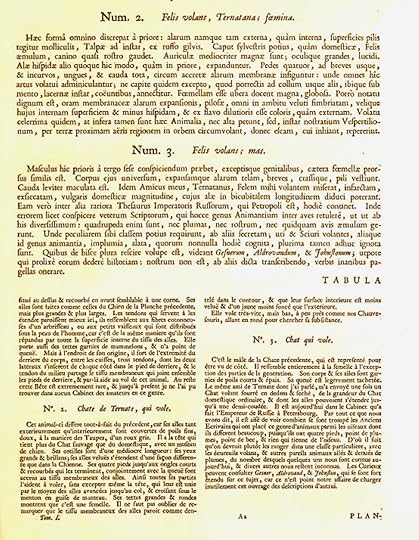 The colugo-relevant Latin and French text from the original 1734 edition of Seba's Thesaurus, Vol. 1
The colugo-relevant Latin and French text from the original 1734 edition of Seba's Thesaurus, Vol. 1So there it is – the mystery laid bare, a mystery no longer. Asia's so-called flying cats were indeed colugos - or flying lemurs, as they are still popularly referred to. Bearing in mind, however, that colugos have very dog-like heads (as indeed have some lemurs, hence 'flying lemur' as a name applied to colugos), it's something of a riddle how they ever came to be dubbed 'flying cats', but at least the suspected connection has now finally been verified.
Only one mysterious aspect of this case remains unsolved. Colugos are southeast Asian species; they are not native to anywhere in India - including the disputed Kashmir territory (remember Kircher's bat-cat?). Perhaps, therefore, the Gibson 'flying cat' was not actually shot in India after all, but had merely been preserved or exhibited there - with the claim that it had originally been shot there too merely being a journalistic error. It certainly wouldn't be the first time that an unusual animal has incited all manner of outlandish, error-ridden reporting by poorly-informed or overly-imaginative hacks.
Far less likely, but by no means impossible, and certainly much more intriguing, is the possibility that there were once (and maybe still are?) colugos belonging to one or other of the two known species– or perhaps even to an entirely-distinct third colugo species – inhabiting regions of Asia such as India and Kashmir that fall outside their currently-confirmed modern-day distribution range, but have remained undiscovered and undescribed by science. Who knows – those erstwhile 'flying cats' may still have the potential to surprise us after all.
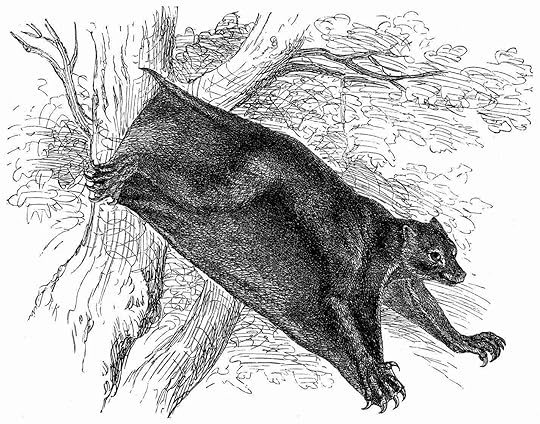 19th-Century engraving of a Philippines colugo
19th-Century engraving of a Philippines colugo
Published on April 04, 2014 16:21
March 31, 2014
REMEMBERING MY MOTHER
 Mom, wearing the beautiful protea-decorated coat that she purchased in Cape Town, South Africa, in 2008 (© Dr Karl Shuker)
Mom, wearing the beautiful protea-decorated coat that she purchased in Cape Town, South Africa, in 2008 (© Dr Karl Shuker)Today it is one year since, on Easter Monday (1 April) 2013, my dear mother, Mary Doreen Shuker, passed away, leaving me totally devastated at the loss of the most wonderful, loving person in my life. During the days, weeks, and months that have followed this traumatic event, I have sought to put into words just how much she has always meant to me, how profoundly influential she has been throughout my life, and how grief-stricken I remain by her passing. Here is a selection of what I have written and compiled.
Whatever good there may be in me came from you.Thank you for blessing my life by being in itas my mother.You were, are, and always will be quite simplythe best person I shall ever know,and I love you with all of my heart.God bless you, little Mom,please wait for me,watch over me in this lonely existence of mine now,and come for me when my time here is over.Au revoir, Mom, until we meet again.
My tribute to Mom, posted on my Facebook wall on 1 April 2013 when announcing her passing; and it is also my Dedication to her in my book 'Mirabilis' (Anomalist Books: New York, 2013).
"Beauty was hers in all its brightness and she was determined to embrace every shape, line and color imbued in her spirit."
Quotation on the lid of the memory box (pictured here) that I bought for my Mom a few hours ago; it describes her perfectly - indeed, it could have been written specifically for her.
God bless you, little Mom - how I wish you were still here with me.

Posted on my Facebook wall on 8 April 2013.
God bless you, Mom.Thank you for everything that has ever been good in my life.How I wish that you were still here with me, fit and well,ready to set off with me on our next adventure together.I love you, little Mom, always.
The concluding words in my eulogy to Mom, which I read aloud at her funeral on 16 April 2013 (and which can be read in full online here on ShukerNature).
13 weeks ago this evening, my dear little Mom passed away -a whole quarter-year has somehow gone by,during which time I have found myself locked inside a strange and very sad new life.I can never return to the past, except in dreams,and the future is as ever opaque.And so I live life now a moment at a time,and dream...
Posted on my Facebook wall on 1 July 2013
 A hand-coloured photograph of Mom in her 20s during the 1940s (© Mary D. Shuker/Dr Karl Shuker)
A hand-coloured photograph of Mom in her 20s during the 1940s (© Mary D. Shuker/Dr Karl Shuker) I attended my Mom's Memorial Service tonight at church,and I placed a candle for her on a table before me,where its light gently flickered until the end of the service, after which, once I had left the church, it would be extinguished.
But the candle of love that my Mom had lit inside my heart on the day that I was born,and which now burns there for her,is infinitely brighter, warmer, and will never be extinguished.
And although the memorial service for my Mom in church is over now,the memorial service for her that has been performing inside my mind every moment of every day since she passed away will never come to an end –it will continue in perpetuity for the rest of my life.
God bless you Mom - I love you, always.

Posted on my Facebook wall on 21 July 2013 following my attendance of my Mom's Memorial Service earlier that evening.
One part of the show that really registered with me was the song 'They Live In You',when the shaman-type mandrill Rafiki was telling the adult Simba that his father will always be a part of him,will always live in him,and that when he looks into the mirror of a forest pool,he will see his father in his own reflection,looking back at him.I'd never thought of that before.
Also, several people have told me that I have my Mom's eyes, different colour but same shape and depth;and Mom often joked that I had her squat, pudgy nose,and I do.
So now, whenever I look into a mirror,I'll see Mom there in my reflection,spiritually and physically,looking back at me,and I'll know that she is part of me,is with me still,forever.
Posted on my Facebook wall on 10 August 2013 after attending a performance of Disney's 'The Lion King' stage musical at the Birmingham Hippodrome that afternoon.
This evening marks exactly 26 weeks = 6 months = half a year since my mother, Mary Shuker, passed away, leaving behind an aching void inside my heart that I have papered over with memories but which can never be filled and will never heal. I recently came upon the following words while browsing online, which encapsulate so many of my own thoughts, feelings, truths, and beliefs. God bless you Mom, how I miss you and wish you were here with me still. With all my love:
 Posted on my Facebook wall on 30 September 2013.
Posted on my Facebook wall on 30 September 2013.This morning, I visited the newly-completed gravestone of my mother, Mary Doreen Shuker (1921-2013), which has taken 6 months to prepare. Standing there in the solitude of the cemetery, it all still seemed so unreal, that the vibrant little lady always so full of life, of living, and of love was gone, her time in this world marked only by the stone and grave there before me, beautiful and elegant though they were, just like she had always been. Come the closing of December, I shall not grieve the passing of 2013, but I shall forever grieve the passing within it of my mother, whose light is gone from my world until that joyous day when we will be reunited forever.
From the introduction to my composition 'The Chained Gates' (click here to read it in full on my Star Steeds blog), written by me on 22 October 2013.
2013
I shall not mourn the passing of this year,Nor shall I mourn its months of grief and strife.All I shall mourn is that one person dear,My mother, whom it stole out of my life.
God bless you, Little Mom - I love you always.Happy New Year - may we be together again one day.
 One of my framed photographs of Mom (© Dr Karl Shuker)
One of my framed photographs of Mom (© Dr Karl Shuker) Composed by me and posted on my Facebook wall on 31 December 2013.
Happy Birthday in Heaven, Mom- how I wish that I could share it with you.God Bless.

Posted on my Facebook wall on my mother's birthday, 29 January 2014.
To my dear mother, Mary D. Shuker (1921-2013), whose lifelong interest in wildlife guided and encouraged my own from my earliest days. Thank you for filling my world with wonder, joy, and love for such a long and very happy time. How I miss you, and how I wish that you were still here with me today and always. God bless you, little Mom.
"The mother's heart is the child's schoolroom."
Henry Ward Beecher – Life Thoughts
My Dedication to my mother in my forthcoming book, 'The Menagerie of Marvels: A Third Compendium of Extraordinary Animals' (CFZ Press: Bideford, in press; due for publication in summer 2014).
 Mom, wearing one of her favourite and most beautiful jumpers (© Dr Karl Shuker
)
Mom, wearing one of her favourite and most beautiful jumpers (© Dr Karl Shuker
)
"Remembrance is the only paradise out of which we cannot be driven away."
Jean Paul Friedrich Richter
The above quotation, chosen long ago by my mother, is inscribed upon the tombstone of the first of my family's two three-person grave plots. Here lie her parents (my Nan and Grandad), Gertrude and Ernest Timmins, and her first husband, Harold Hooper - who died aged only 30 as a result of serving in the armed forces during World War II.
How very true is that quotation, which must have been such a source of comfort to her in the face of her great losses, and which is now of equal comfort to me in the face of mine.
"God gave us memories so that we may have roses in December."
Adapted from a line in a rectorial address given by James M. Barrie on 3 May 1922 at St Andrews University, Scotland.
The above quotation, also chosen long ago by my mother, is inscribed upon the tombstone of my family's second three-person grave plot, situated alongside the first one. Here is where my little brother André (who passed away in 1955) and my mother lie, and where, when it is my time, I too shall lie, reunited at last with my family and never to be parted from them again.

Time waits for no-one, for nothing, not even for grief. Tomorrow will be 52 Saturdays since Mom and I set off on what would be our last outing together, though mercifully we had no realisation of that at the time, and had a lovely afternoon. On Sunday it is Mother's Day this year, and it will also be 52 Sundays since Mom was taken ill late that evening. Monday will be 12 months to the day since she gently slipped away early that evening in hospital, with me beside her, holding her hand and telling her how much I loved her. And Tuesday will be 12 months to the date since that most traumatic of all events in my life happened - the event that I had always dreaded most throughout my entire time here on earth. So, wish me well during the next four very momentous days for me, as they revive all of those mixed memories, and bring to a close the worst year of my life - a year which, if I am honest, I may not have survived had it not been for the kind words and continuing support of so many friends here on Facebook. So thank you all - I am truly grateful.
 Mom in our garden (© Dr Karl Shuker)
Mom in our garden (© Dr Karl Shuker)Above is a photo of Mom in happier times, wearing one of her beautiful, vibrant coats that she loved so much, epitomising her own lifelong love of Nature's wonders and beauty, and which she nurtured in me too from my earliest days. Thank you, little Mom, how I wish that you were still here.
Posted on my Facebook wall on 28 March 2014.
 The card that I bought for Mom for Mother's Day this year, 30 March 2014, continuing a tradition that shall last for as long as I last.
The card that I bought for Mom for Mother's Day this year, 30 March 2014, continuing a tradition that shall last for as long as I last.Can it be just a year ago today since you passed from my life, my little Mom?
Sometimes it seems but a heartbeat away, other times a thousand lives, a thousand worlds, from where I am now.
People try to show sympathy and understanding when they learn that you have gone, but they have no concept of the true nature of my loss - the immeasurable breadth and limitless depth of the black chasm created in my life and within my heart by your passing. Yes, I have indeed lost my mother - a loss that in itself would be all but unbearable. But I have also lost my best friend, my ever-present housemate, my constant travelling companion, my most trusted confidante, my number one supporter, and my entire family. You were all of those persons, Mom, and so much more besides. Is it any wonder why I grieve without ending, why my life is now but a paltry, meaningless existence, a mere shadow of its former state, why I look only to the past for happiness and security now, and to the future with only loneliness and fear?
I never cried as a child, because I'd never give the school bully, the playground tormentor, the satisfaction of seeing my tears. Instead, I'd save them all, each one a precious pearl of emotion, only to be released in my darkest of all hours some day. Well that day and that hour finally came, a year ago today, the hour in which I lost you, Mom. The tears flowed, and have continued to flow ever since - every tear that I've ever saved throughout my life, torrents of tears that even now after a year of unbroken outpouring continue in unabated profusion, threatening to drown my very being in their salty, burning despair, or to carry me away, borne upon a veritable ocean of tears to who knows where.
. . .
This first year of being without you, of being alone in this world, knowing that wherever I look, whichever street I walk along, whatever shop I walk into, I shall never see you again, shall never hear your voice speaking to me again, shall never see your face in the crowd looking for mine again, has been the worst time of my life. Nothing ever will, ever could, be as devastating, but I shall miss you always, all the days of my life. I now stand on the brink of entering my second year alone, and I can only pray that acceptance will at last be mine, that grief will lift and give me a measure of release, of peace, and that I shall be worthy of you, Mom, that I shall go on to achieve all that you have ever hoped and dreamed for me.
God bless you, little Mom. Please always stay beside me where you always used to be when here, please always give me hope and encouragement as you always used to do when here, and, above all else, please always love me as you always did when here. If you will do these, I will do the rest – this I promise you, Mom, with all my heart and with all my love, always.
Excerpts from my composition 'A Year Ago Today', which will be uploaded onto my Star Steeds blog later today, on this first anniversary of my mother's passing.
 Happy days: Setting off on another adventure together – Mom and I on our outward-bound Emirates flight to Dubai and the Far East, 2005 (© Dr Karl Shuker)
Happy days: Setting off on another adventure together – Mom and I on our outward-bound Emirates flight to Dubai and the Far East, 2005 (© Dr Karl Shuker)
Published on March 31, 2014 16:09
March 12, 2014
THE STRIPED ANTEATER THAT MADE A BUFFOON OUT OF BUFFON
 Colour plate of the fraudulent striped tamandua from Buffon's Histoire Naturelle (1749-1788)
Colour plate of the fraudulent striped tamandua from Buffon's Histoire Naturelle (1749-1788)There are four recognised species of modern-day South American anteater – or vermilinguan, to be taxonomically precise (the unrelated aardvark, the pangolins, and the echidnas are all sometimes referred to colloquially as anteaters too – respectively, the African anteater, the scaly anteaters, and the spiny anteaters). These are: the giant anteater Myrmecophaga tridactyla; the pygmy or silky anteater Cyclopes didactylus; and somewhat midway in size between these two species, the northern tamandua Tamandua mexicana and the southern tamandua T. tetradactyla (these two were previously lumped together as a single species, the tamandua T. tetradactyla).
Each of the two tamandua species is itself split into four subspecies, and although the most familiar appearance in both species is one in which the animal possesses a black vest-like coat pattern over its torso, with the remainder of its body and also its head of paler colouration, there is much variation in both coat colour and pattern.
 Beautiful painting of a tamandua by J.G. Keulemans from 1871
Beautiful painting of a tamandua by J.G. Keulemans from 1871Variation notwithstanding, however, no tamandua had ever been reported before (or, indeed, has been since) that even remotely resembled a certain extraordinary specimen sent during the 1700s to the pre-eminent French naturalist Georges-Louis Leclerc, Comte de Buffon (1707-1788), for examination. What made it unique was that, totally eschewing the traditional 'black vest vs paler elsewhere' tamandua image noted above, this particular individual was very distinctively patterned all over its body, legs, tail, and even its long snout with bold, highly contrasting black and gold stripes!
Needless to say, Buffon was captivated by this veritable bumblebee in anteater form, and in 1763 he duly incorporated it as a major new species, the striped tamandua, in his monumental, 36-volume magnum opus, Histoire Naturelle (1749-1788) (NB - one of the southern tamandua's four subspecies is also referred to sometimes as the striped tamandua, but it bears no resemblance to the singular specimen documented here, so it should not be confused with this latter animal). He even commissioned a full-colour plate for his Histoire Naturelle, portraying his striped tamandua there in all its banded beauty, which is the image opening this present ShukerNature post, and to my knowledge the only depiction of this creature ever produced.
 Portrait of Georges-Louis Leclerc, Comte de Buffon, by François-Hubert Drouais (1725-1775)
Portrait of Georges-Louis Leclerc, Comte de Buffon, by François-Hubert Drouais (1725-1775)Tragically for Buffon's reputation, however, when the striped tamandua's holotype was examined by other zoologists after his death, it was discovered that he had been the victim of a cunning hoax. The creature was not a tamandua at all, but was instead a coati – a long-nosed relative of the raccoons, occurring in three recognised species – which had been deftly modified to resemble an anteater (even its teeth had been removed), and whose stripes were equally artificial. The perpetrator of this cruel practical joke was never identified, but once their hoax had been exposed, the now-fraudulent striped tamandua made a swift, unmourned exit from the natural history tomes, never to return.
 A ring-tailed coati Nasua nasua from South America
A ring-tailed coati Nasua nasua from South America
Published on March 12, 2014 18:50
ALBERTUS SEBA AND A PAIR OF SPECKLE-COATED MYSTERY BIG CATS FROM THE 1750S
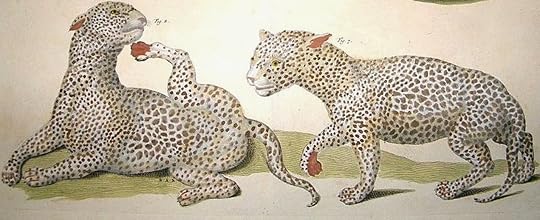 A pair of anomalous speckle-coated 'tigers' depicted in a 1750s plate from Albertus Seba's Thesaurus
A pair of anomalous speckle-coated 'tigers' depicted in a 1750s plate from Albertus Seba's ThesaurusIn yesterday's ShukerNature blog post (click here ), I presented a selection of speckle-coated mystery big cats reported from various parts of South America. Now, less than a day later, I'm able to present a very unexpected but fascinating update to this subject.
As so often happens during my cryptozoological researches, while seeking something entirely different while browsing online this morning I came upon a remarkable engraving that may have some bearing upon the speckled mystery cat saga.
Albertus Seba (1665-1736), a Dutch pharmacist by trade but inflamed by an unquenchable passion for collecting zoological specimens, was so successful financially in his work that he was able to assemble not one but two truly spectacular, prodigious collections of unprecedented size and scope that gained international acclaim. Indeed, the first of these collections was so astonishing that in 1716 it was purchased in its entirety by no less a celebrated figure than the Russian tsar Peter the Great; the second was auctioned in 1752 in Amsterdam, and several prize specimens were purchased by what was then the St Petersburg Academy of Sciences, founded by Peter the Great (but merging in 1841 with the Russian Academy to become the present-day Russian Academy of Sciences).
 Portrait of Albertus Seba, by Jacobus Houbraken (1698-1780)
Portrait of Albertus Seba, by Jacobus Houbraken (1698-1780)Perhaps Seba's most lasting claim to fame, however, is his magnificent four-volume Thesaurus (published 1734-1765). Its full, dual Dutch-Latin title is Locupletissimi rerum naturalium thesauri accurata descriptio – Naaukeurige beschryving van het schatryke kabinet der voornaamste seldzaamheden der natuur, which translates as 'Accurate description of the very rich thesaurus of the principal and rarest natural objects', and it is basically an exquisitely-illustrated catalogue of every zoological specimen that Seba had collected, containing 446 full-colour folio-sized copper plates. A copy of this wondrous work sold at auction a few years ago for the staggering sum of US $460,000, but a modern reprint, entitled Albert Seba Cabinet of Natural Curiosities and compiled by Irmgard Müsch, Jes Rust, and Rainer Willmann, was issued by Taschen in 2001, followed by further printings more recently. Purchased directly from Taschen, a hardback copy currently costs £125 (shipping may be additional).
Detailed scans of many if not all of the plates from Seba's Thesauruscan also be found online, and most of the animals depicted in them are portrayed very accurately, especially given the pre-scientific time period in which this publication was prepared. While browsing a collection of these sumptuous plates on the website Albion Prints website (www.albion-prints.com), I came upon a fascinating example, whose date was given as the 1750s, depicting a series of colour morphs of moles in the top section, but with the rest of the plate devoted to a pair of very remarkable-looking big cats. Here is that plate:
 A pair of anomalous speckle-coated 'tigers' (and also a series of mole colour morphs) depicted in a 1750s plate from Albertus Seba's Thesaurus
A pair of anomalous speckle-coated 'tigers' (and also a series of mole colour morphs) depicted in a 1750s plate from Albertus Seba's ThesaurusAccording to the description given for the plate, these cats were tigers! I am not sure whether this identification is the original one given by Seba in his Thesaurus, or is simply one hazarded by the owner of the website containing the scans, but what I am sure of is that whatever these pale-furred, liberally spotted cats may be, they are certainly not the orange-furred, unequivocally -big cat that we all know as the tiger, unless...?
What if the term 'tiger' was being used here not in relation to Panthera tigris, but rather in its Latin American meaning, i.e. 'jaguar'? Yet these illustrated cats possess no trace of the jaguar's normal rosettes and they lack its fur's deep orange background colouration too, being patterned all over instead with an array of solid black dots or speckles upon a virtually white background - thereby greatly resembling the alleged appearance of Peru's speckled tiger aka Anomalous jaguar.
As one of the greatest zoological collectors of all time, if anyone were likely to obtain specimens of this most exotic, elusive form of South American crypto-cat, Seba would have to be a primary candidate for achieving such a feat.
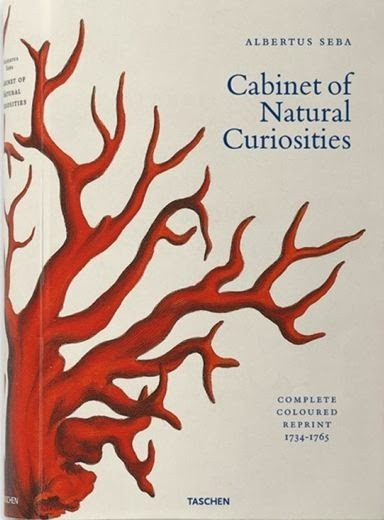 The modern-day Taschen reprint of Albertus Seba's Thesaurus, entitled Albert Sebe Cabinet of Natural Curiosities (© Taschen)
The modern-day Taschen reprint of Albertus Seba's Thesaurus, entitled Albert Sebe Cabinet of Natural Curiosities (© Taschen)Needless to say, I realise that this is all highly speculative. It may simply be that the two cats are very inaccurate representations of normal jaguars, or even leopards (their non-gracile body proportions and lack of teardrop facial markings argue strongly against their being cheetahs). Yet in view of how accurate other depictions of animals are in Seba's Thesaurus, this seems strange.
In any event, they are certainly tantalising enough in appearance to warrant inclusion in any coverage of speckled mystery cats, just in case they are relevant and any further investigation of them can be achieved. So if anyone reading this ShukerNature blog post should happen to own a modern-day Taschen reprint of Seba's Thesaurus, I would very greatly welcome any news of what identity was given in it for these two speckle-coated big cats. Thanks very much!
For plenty of additional information concerning a wide diversity of South American mystery cats, be sure to check out my two mystery cat books – Mystery Cats of the World (1989) and Cats of Magic, Mythology, and Mystery (2012)

Published on March 12, 2014 10:10
March 10, 2014
ANOMALOUS JAGUARS AND OTHER SPECKLED MYSTERY CATS FROM SOUTH AMERICA
 Jardine's enigmatic 19th-Century illustration of a putative speckle-coated jaguar
Jardine's enigmatic 19th-Century illustration of a putative speckle-coated jaguarI was pleased to learn yesterday that the long-awaited paper that I obliquely alluded to in my book Cats of Magic, Mythology, and Mystery (2012), providing an extensive morphometric analysis of two skulls from two different types of Peruvian mystery big cat, has finally been published (click here to access it). It is co-authored by British palaeontologist Dr Darren Naish, who also has a longstanding interest in cryptozoology. The two mystery cats whose skulls are featured in the analysis are what another of this paper's four co-authors, Peru-based zoologist Dr Peter J. Hocking (who also obtained the skulls), originally called the speckled tiger ('tiger' being a prevalent term throughout Latin America for the jaguar Panthera onca) but which is renamed the Anomalous jaguar in the paper, and what Hocking originally called the striped tiger but which is renamed the Peruvian tiger in the paper. Based upon the results of the analysis, in which both skulls were shown to fall within the documented range for the jaguar, the paper's authors conclude that these specimens were indeed jaguars, but ones that exhibited aberrant pelage markings.
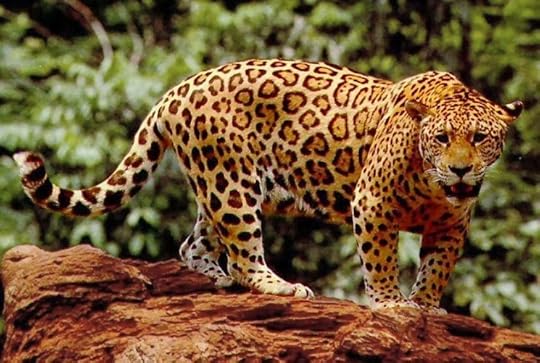 A jaguar exhibiting normal pelage markings and colouration
A jaguar exhibiting normal pelage markings and colourationI'll comment further re the Peruvian tiger in a future ShukerNature blog post, as I wish to concentrate in this present blog post upon the Anomalous jaguar, because my Cats of Magic, Mythology, and Mystery book contains some additional information – and one fascinating 19th-Century illustration – that may be of relevance to this speckled South American crypto-felid that has long fascinated me. Here are the relevant excerpts from my book:
In 1992, within the International Society of Cryptozoology's journal, Cryptozoology,Peruvian zoologist Dr Peter J. Hocking presented some previously unpublished evidence for the existence amid Peru's remote tropical forests of four different types of mystery cat, all possibly new to science…
 Three Peruvian mystery cats – speckled tiger, striped tiger, and giant black panther/yana puma (© Peter Visccher/BBC Wildlife Magazine)
Three Peruvian mystery cats – speckled tiger, striped tiger, and giant black panther/yana puma (© Peter Visccher/BBC Wildlife Magazine)Even more intriguing [than the Peruvian giant black panther or yana puma, which was the first of the four to be documented by me in my book] is the 'speckled tiger' - claimed by locals to be as big as a jaguar (jaguars, incidentally, are popularly termed 'tigers' in South America), but with a larger head, and a unique pelage consisting of a grey background covered with solid black speckles. There is no known species of South American cat alive today that fits this description - so what could this mottled mystery cat from the montane tropical forests of Peru's Pascoprovince be?
A jaguar with a freak coat pattern and colouration is the most reasonable explanation, but this poses problems. The pelage of a complete albino jaguar (i.e. homozygous for the complete albino mutant allele of the Full Colour gene) would have white background colouration and normal but white rosettes visible only in certain lights, like watered silk; and even a chinchilla-reminiscent specimen (analogous or homologous to the white lions of Timbavati and/or the white tigers of Rewa) would have normal rosettes, probably grey or pale brown. So too would a leucistic specimen (see Chapter 3). Interestingly, on 19 January 2012, two white jaguar cubs with pale grey rosettes and normal green eyes were born to a typical rosetted father and a melanistic mother at Aschersleben Zoo, in Germany; the first white jaguars born in captivity as far as is known, they are most probably leucistic, as indicated by their normal eye colour and the pale, washed-out appearance of their coat.
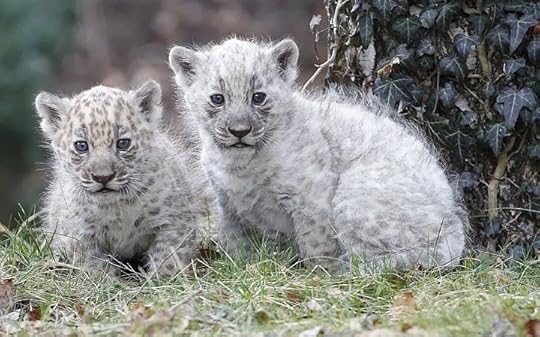 The white jaguar cubs of Aschersleben Zoo, Germany (© Aschersleben Zoo)
The white jaguar cubs of Aschersleben Zoo, Germany (© Aschersleben Zoo)Genetically, the presence of solid black speckles reported for Peru's 'speckled tiger' rather than well-formed rosettes is anomalous. The only comparable case is that of the speckled servaline morph of the serval Leptailurus serval (see Chapter 27), and a couple of servaline-like cheetahs that I have dubbed cheetalines (see Chapter 19).
 Skin of normal blotched serval on left and speckled servaline on right (© Owen Burnham)
Skin of normal blotched serval on left and speckled servaline on right (© Owen Burnham)One other controversial cat reported from South Americathat is somewhat reminiscent of Peru’s speckled tiger is the cunarid din, mentioned by the Wapishana Indians of Guyana and Brazilto Stanley E. Brock. In Hunting in the Wilderness (1963), Brock describes this strange cat as follows:
The cunarid din is quite like the ticar din [normal jaguar], except that the ground colour is nearer white than orange or yellow. The Indians say that the white kind always attain a much larger size than the former, but this is doubtful as a fact. The spots are often finer on the fore quarters and spaced further apart, and there are noticeably fewer spots within the rosettes along the sides of the body, giving the skin a rather leopard-like appearance.
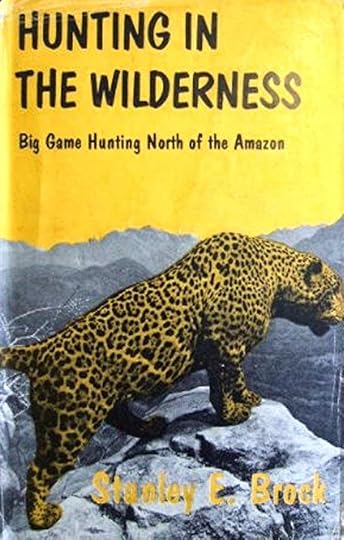 Stanley E. Brock's book, featuring a regular jaguar on the cover (© Stanley E. Brock/Robert Hale Limited)
Stanley E. Brock's book, featuring a regular jaguar on the cover (© Stanley E. Brock/Robert Hale Limited)Moreover, while browsing through a copy of Scottish naturalist Sir William Jardine’s classic Natural History of the Felinae (1834) recently, I was startled to discover a colour plate of a very odd-looking jaguar - whose paler-than-normal coat lacked this species’ familiar, clearly-defined rosettes and instead was patterned entirely with a heterogeneous array of solid black speckles and blotches. According to the plate’s caption, this jaguar was a native of Paraguay. Consequently, always assuming of course that it had been depicted accurately, this suggests that speckled jaguars or jaguar-like cats have also occurred here in the past. Perhaps they may still do so today.
Jardine's enigmatic illustration opens this present ShukerNature blog post and is also presented again here:
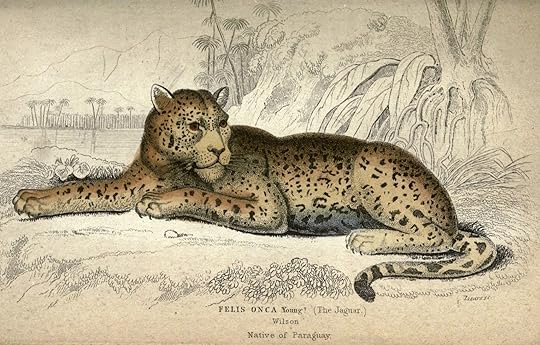 Jardine's enigmatic 19th-Century illustration of a putative speckle-coated jaguar
Jardine's enigmatic 19th-Century illustration of a putative speckle-coated jaguarYet another speckled mystery cat from South America is the shiashia-yawá, one of several crypto-felids said to inhabit Ecuador:
While visiting southern Ecuador's Morona-Santiago province in July 1999, Spanish cryptozoologist Angel Morant Forés learnt of several mystery cats said to inhabit this country’s Amazonian jungles. Upon his return home, he documented them in an online field report, entitled ‘An investigation into some unidentified Ecuadorian mammals’, which he uploaded in autumn 1999 onto French cryptozoologist Michel Raynal’s website, the Virtual Institute of Cryptozoology, where it is still accessible today (at http://cryptozoo.pagesperso-orange.fr/welcome.htm). These very intriguing crypto-felids include:
A white-coated cat with solid black spots known as the shiashia-yawá, recalling the cunarid din of Guyana and Brazil, and Peru’s speckled tiger, but smaller (said to be intermediate in size between a jaguar and an ocelot). Angel considers it possible that this felid is merely an albinistic jaguar, but as already discussed in relation to the speckled tiger, such an identity would not explain its solid black spots, which sound very different from the familiar rosettes of normal jaguars. [My book then continues with descriptions of six other Ecuadorian mystery cats.]
The Anomalous jaguar's speckled pelage may be due to the expression of a homologous, or at least an analogous, mutant gene allele to that which creates the speckled serval and/or speckled cheetah morphs.
For plenty of additional information concerning a wide diversity of South American mystery cats, be sure to check out my two mystery cat books – Mystery Cats of the World (1989) and Cats of Magic, Mythology, and Mystery (2012).
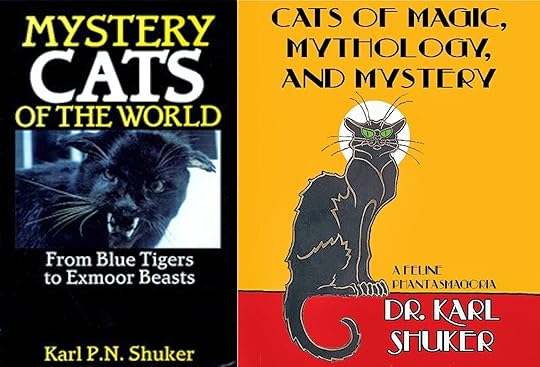
Published on March 10, 2014 21:56
Karl Shuker's Blog
- Karl Shuker's profile
- 45 followers
Karl Shuker isn't a Goodreads Author
(yet),
but they
do have a blog,
so here are some recent posts imported from
their feed.



